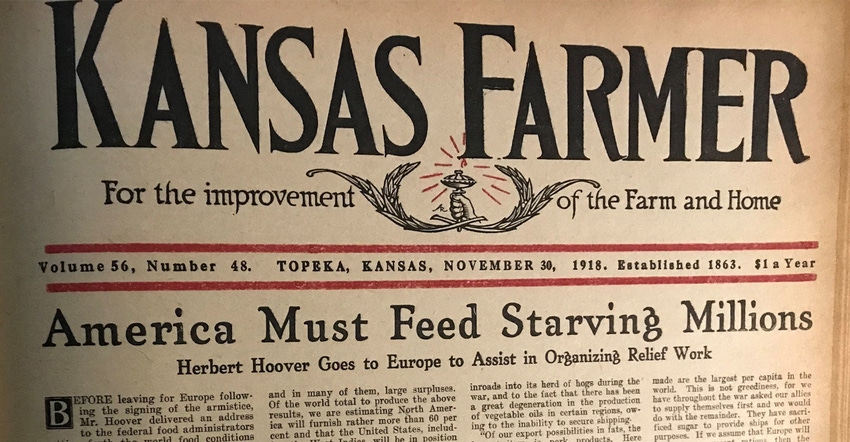October 11, 2018

At the end of November in 1918, World War I was over, but the suffering in Europe was nowhere close to over.
With farms and fields devastated, livestock herds depleted, and thousands of people left homeless, Europe turned to North America for food. The farmers of Kansas and the U.S. were ready to help, preparing to ship wheat, rye and other coarse grains to Europe. Fats, oils and dairy products were also in high demand, and Americans were being asked to limit their own consumption in order share supplies with the rest of the world.
Americans were also warned that everything they could do might not be enough to save millions of people who were trapped without internal transportation and would die of starvation.
70 years ago
Scientist at the U.S. Agricultural Research Service studied the effect of artificial lighting on the laying pattern of hens, testing whether or not using electric lighting to extend the hours of “daylight” would affect egg production.
What they learned was the number of hours of light made little difference. However, feeding times had a major impact. Hens that were fed at 8 a.m. and 4 p.m. laid almost all their eggs in the period of time between feedings.
When feeding time was changed to 8 p.m. and 4 a.m., within 10 days the hens laid almost all their eggs during the electric-lighted nighttime hours.
60 years ago
Kansas was preparing for its largest corn harvest in at least a decade in the fall of 1958. The estimated harvest as 63,520,000 bushels, compared to a harvest of only 44,283,000 bushels the prior year. Estimated average yield was 40 bushels to the acre, the highest yield since record keeping started in 1866.
50 Years Ago
Kansas farmers were discovering an asset that many didn’t realize was there — marketable timber, especially walnut — along the banks of streams in what was generally considered “wasteland.”
The demand for high-quality walnut timber for veneers was high, and the supply nationwide was low. Farmers were urged to consult with their Extension county agent or a forester to get a good idea of the value of their timber and to get several bids before contracting with a buyer.
Farmers were also urged to consider replanting trees to replace harvested walnuts, and to thin and manage their stands of timber to ensure the best profitability.
Goerzen is executive director of Old Cowtown Museum in Wichita.
About the Author(s)
You May Also Like




